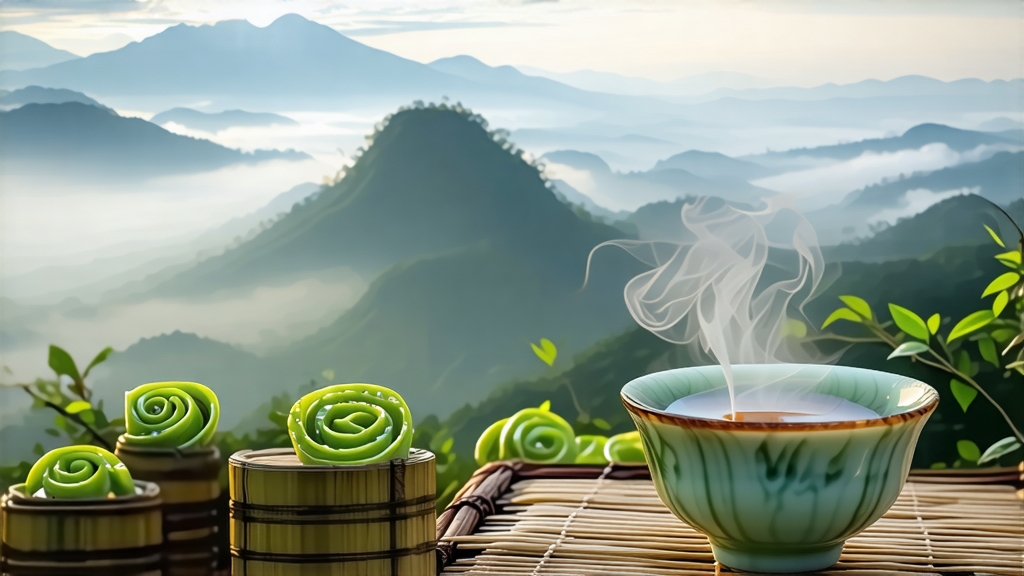
Among the pantheon of Chinese green teas, few names evoke as much poetic reverence as Biluochun. Literally “Green Snail Spring,” the tea is celebrated for its tiny, tightly rolled spirals that resemble miniature jade snails and for the intoxicating bouquet that once caused a Qing-dynasty emperor to rechristen it “Scary Fragrance.” To the international palate, Biluochun offers a gentle gateway into the vast universe of Chinese greens: it is delicate yet complex, floral yet marine, ancient yet eternally fresh.
Historical whispers place the birth of Biluochun in the mist-laden hills of Dongting Mountain beside Taihu Lake, Jiangsu Province. During the late Tang dynasty (9th century), monks from Biyun Temple cultivated wild tea shrubs that thrived under the shade of loquat, plum and apricot trees. The interplanting of fruit and tea—still practiced today—imbued the leaf with a natural fruity sweetness that later scholars would call “the taste of mountain mist and orchard bloom.” When the Kangxi Emperor visited Suzhou in 1699, local magistrate Song Luo presented the curled spring pick; the sovereign, dazzled by its aroma, declared the name too vulgar for imperial lips and coined “Biluochun,” fusing the snail-like shape with the season of harvest.
Strictly speaking, only leaf plucked within the 12-kilometer core zone of Dongting East and West Mountains can claim the protected title “Original Biluochun.” Yet the cultivar’s success has spawned satellite gardens in Zhejiang, Sichuan and even Yunnan, each yielding leaf that echoes, but never fully replicates, the Taihu terroir. Purists divide the tea into five micro-grades: Supreme (Qingming前, pre-April 5), Special (Qingming to Guyu), First (Guyu to early May), Second (mid-May) and Third (late May). The Supreme grade consists solely of an unopened bud and the adjacent half-expanded leaf, picked at dawn when the dew still acts as a natural protective film against bruising.
Crafting Biluochun is a race against time and oxidation. Within minutes of plucking, the fragile leaf is spread in bamboo trays no thicker than three centimeters and withered for 30–40 minutes in shaded draft. The goal is to reduce surface moisture to 70 % without allowing grassiness to intensify. Next comes the unique “killing-green while rolling” step: the leaves are tossed into a drum pan pre-heated to 180 °C. For six minutes the master’s bare hands flutter through the searing leaf, simultaneously fixing the green pigment and beginning the spiral shape. Temperature is then dropped to 70 °C and the real sculpting begins. Using a whisper-light touch, the master coaxes each bud-leaf pair into a tight coil through a rhythmic sequence of shaking, pressing and rubbing against the wok’s wall. One kilogram of finished tea demands 60,000 individual manipulations, all performed before the leaf cools below 40 °C. Finally, the spirals are dried in three passes: first at 60 °C to lock the curl, then 50 °C to reduce moisture to 7 %, and a last gentle 40 °C bake to awaken the signature fruity note. The entire process, from mountain to tin, spans fewer than eight hours.
Brewing Biluochun is an exercise in restraint. Its cell structure is so tender that boiling water will literally cook the leaf, releasing bitter amino acids and flattening the aroma. The international standard is 3 grams per 150 ml, but Chinese connoisseurs often push the ratio to 2 grams to amplify sweetness. Water should be 75–80 °C, best achieved by decanting freshly boiled water into a fairness pitcher and waiting 45 seconds. Glass vessels are favored because they allow the “three-stage dance” to unfold: the spirals first sink, then stand upright like miniature green flags, and finally drift back down in slow motion. The first infusion lasts 45 seconds; subsequent steeps add 15 seconds each. A seven-minute marathon infusion—popular in Nordic cafés—extracts a surprisingly honeyed liquor without astringency, but demands an ice-water bath immediately afterward to halt extraction.
Tasting Biluochun is best approached as a vertical journey. Begin by